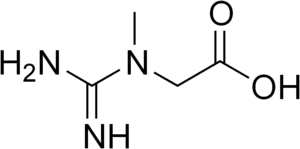Creatine: Difference between revisions
No edit summary |
No edit summary |
||
| Line 1: | Line 1: | ||
[[File:Creatine neutral.png|thumb|Creatine (formula)]] | |||
'''Creatine''' is an organic acid, nitrogen compound derivative, which is synthesised endogenously in the liver and the kidneys, but it is stored and utilised mainly in the skeletal muscle. | |||
'''Creatine''' is an organic acid, nitrogen compound derivative, which is synthesised endogenously in the liver and the kidneys, but it is stored and utilised mainly in the skeletal muscle. | |||
IUPAC name: 2-[carbamimidoyl(methyl)amino]acetic acid <ref> | IUPAC name: 2-[carbamimidoyl(methyl)amino]acetic acid <ref> | ||
| Line 13: | Line 12: | ||
}} </ref> | }} </ref> | ||
''' | Creatine is produced from the biosynthesis of the essential amino acids '''L-glycine''' and '''L-arginine''' and then is methylated - SAM, or can be obtained from '''dietary sources'''. | ||
# | [[File:CreatineSynthesis(en).png|thumb|Synthesis of creatine]] | ||
# | Synthesis occurs in two steps: | ||
# kidneys: a guanidine group is transferred with the help of a ''transaminidase'' enzyme from arginine to glycine, which results in the formation of guanidinoacetate | |||
# liver: methylation of guanidinoacetate results in the creatine formation, SAM (S-adenosylmethionine) is a coenzyme in this reaction | |||
The main dietary sources of '''creatine''' are meat and fish. Creatine is absorbed in the small intestine and enters the circulation and is then distributed into various tissues of the body - most importantly muscle and PNS/CNS<ref>{{Cite|type=web|corporation=National Center for Biotechnology Information|source_name=PubChem Compound Summary for CID 586, Creatine|publisher=National Library of Medicine|cited=2022-11-12|url=https://pubchem.ncbi.nlm.nih.gov/compound/Creatine}}</ref>. | |||
Creatine is '''phosphorylated''' in the '''skeletal muscle''' (enzyme: ''[[creatine kinase]]'') to form '''creatine phosphate''' (CP, also phosphocreatine), which then serves as a quickly-accessible source of energy in tissues with fluctuating energy requirements, such as the skeletal muscle and the brain. [[Creatine phosphate]] contains a high-energy phosphate (macroergic) bond. As soon as the muscle contraction begins, the muscle needs a fast supply of ATP and so the macroergic phosphate is transferred from creatine phosphate to ADP, which results in the formation of ATP and creatine. | |||
[[File:Cyclization of Creatine.svg|thumb|247x247px|Cyclization of Creatine]] | |||
The energy resources in the form of creatine phosphate can cover the energy requirements of a working muscle for the '''first 10 seconds'''. Both creatine and creatine phosphate are fairly unstable molecules, which <u>spontaneously</u> undergo <u>non-enzymatic cyclisation</u> to '''[[creatinine]]''' in the muscle cells. Creatinine is a waste product of the muscle as it cannot be phosphorylated and used as an energy storage so is passed to circulation and excreted in the urine. | |||
==References== | ==References== | ||
===Related articles=== | ===Related articles=== | ||
*[[ | *[[Creatine Kinase / Assay]] | ||
*[[ | *[[Creatin phosphate|Creatine phosphate]] | ||
*[[ | *[[Creatinine]] • [[Creatinine clearance]] | ||
*[[ATP]] • [[ | *[[ATP]] • [[Contraction in skeletal muscle]] | ||
===Bibliography=== | ===Bibliography=== | ||
*{{Citace | *{{Citace | ||
Revision as of 14:08, 12 November 2022
Creatine is an organic acid, nitrogen compound derivative, which is synthesised endogenously in the liver and the kidneys, but it is stored and utilised mainly in the skeletal muscle.
IUPAC name: 2-[carbamimidoyl(methyl)amino]acetic acid [1]
Creatine is produced from the biosynthesis of the essential amino acids L-glycine and L-arginine and then is methylated - SAM, or can be obtained from dietary sources.
Synthesis occurs in two steps:
- kidneys: a guanidine group is transferred with the help of a transaminidase enzyme from arginine to glycine, which results in the formation of guanidinoacetate
- liver: methylation of guanidinoacetate results in the creatine formation, SAM (S-adenosylmethionine) is a coenzyme in this reaction
The main dietary sources of creatine are meat and fish. Creatine is absorbed in the small intestine and enters the circulation and is then distributed into various tissues of the body - most importantly muscle and PNS/CNS[2].
Creatine is phosphorylated in the skeletal muscle (enzyme: creatine kinase) to form creatine phosphate (CP, also phosphocreatine), which then serves as a quickly-accessible source of energy in tissues with fluctuating energy requirements, such as the skeletal muscle and the brain. Creatine phosphate contains a high-energy phosphate (macroergic) bond. As soon as the muscle contraction begins, the muscle needs a fast supply of ATP and so the macroergic phosphate is transferred from creatine phosphate to ADP, which results in the formation of ATP and creatine.
The energy resources in the form of creatine phosphate can cover the energy requirements of a working muscle for the first 10 seconds. Both creatine and creatine phosphate are fairly unstable molecules, which spontaneously undergo non-enzymatic cyclisation to creatinine in the muscle cells. Creatinine is a waste product of the muscle as it cannot be phosphorylated and used as an energy storage so is passed to circulation and excreted in the urine.
References
Related articles
- Creatine Kinase / Assay
- Creatine phosphate
- Creatinine • Creatinine clearance
- ATP • Contraction in skeletal muscle
Bibliography
- National Center for Biotechnology Information. PubChem Compound Summary for CID 586, Creatine [online]. National Library of Medicine, [cit. 2022-11-12]. <https://pubchem.ncbi.nlm.nih.gov/compound/Creatine>.
Kategorie:Biochemie Kategorie:Slovník fyziologie Kategorie:Významně pozměněné zkontrolované články Kategorie:Fyziologie
- ↑ National Center for Biotechnology Information. PubChem Compound Summary for CID 586, Creatine [online]. National Library of Medicine, [cit. 2022-11-12]. <https://pubchem.ncbi.nlm.nih.gov/compound/Creatine>.
- ↑ National Center for Biotechnology Information. PubChem Compound Summary for CID 586, Creatine [online]. National Library of Medicine, [cit. 2022-11-12]. <https://pubchem.ncbi.nlm.nih.gov/compound/Creatine>.




